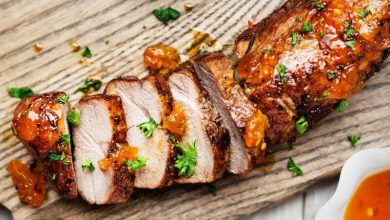Alaskan Curried Shrimp is a delightful seafood dish with flavors influenced by Alaskan and Indian cuisines. Here’s a detailed breakdown of its history, components, preparation steps, and approximate preparation time:
History:
The exact origin of Alaskan Curried Shrimp is not well-documented, but it likely emerged as a fusion of Alaskan seafood with Indian curry spices. Alaska is known for its abundant seafood, and incorporating curry flavors into shrimp dishes offers a unique and delicious twist.
Components:
To prepare Alaskan Curried Shrimp, you will need the following components:
- Shrimp: Fresh or frozen shrimp are the star of this dish. You can use large, peeled, and deveined shrimp.
- Curry Sauce: This typically includes a mixture of ingredients such as curry powder, coconut milk, garlic, ginger, onions, tomatoes, and various spices.
- Vegetables: Common vegetables used include bell peppers, peas, and carrots, but you can customize based on your preferences.
- Cooking Oil: To sauté the shrimp and vegetables.
- Seasonings: Salt, pepper, and additional spices as desired.
- Garnishes: Fresh cilantro or parsley for garnish adds a burst of freshness and color.
Preparation Steps:
-
Prepare the Shrimp: If using frozen shrimp, thaw them according to the package instructions. Pat them dry with paper towels and season with salt and pepper.
-
Make the Curry Sauce: In a large pan or skillet, heat some cooking oil over medium heat. Add finely chopped onions, garlic, and ginger. Sauté until they become translucent.
-
Add Curry Spices: Stir in curry powder and any additional spices like cumin, coriander, or chili powder, depending on your taste. Cook for a minute until fragrant.
-
Add Vegetables: Add the chopped vegetables to the pan. Cook them until they start to soften, usually for about 5-7 minutes.
-
Cook Shrimp: Push the vegetables to one side of the pan and add the seasoned shrimp to the other side. Cook the shrimp for 2-3 minutes per side until they turn pink and opaque.
-
Combine and Simmer: Mix the shrimp and vegetables together. Pour in the coconut milk and diced tomatoes. Reduce the heat to low, cover the pan, and simmer for about 10-15 minutes, or until the shrimp is fully cooked and the sauce has thickened.
-
Adjust Seasoning: Taste the curry and adjust the seasoning with salt and pepper as needed. You can also add a squeeze of lime juice for extra freshness.
-
Serve: Garnish the Alaskan Curried Shrimp with fresh cilantro or parsley. It’s typically served over steamed rice or with naan bread.
Preparation Time:
The approximate time needed to prepare Alaskan Curried Shrimp is around 30-40 minutes, depending on your cooking experience and the size of the shrimp. This makes it a relatively quick and flavorful seafood dish to enjoy.
Now, you have all the information you need to prepare this delicious Alaskan Curried Shrimp dish! Enjoy your culinary adventure!
Certainly, here are some nutrition facts and health information related to Alaskan Curried Shrimp:
Nutrition Facts (Approximate values per serving):
- Calories: 300-350 kcal
- Protein: 25-30 grams
- Carbohydrates: 15-20 grams
- Dietary Fiber: 3-5 grams
- Total Fat: 15-20 grams
- Saturated Fat: 10-12 grams
- Cholesterol: 150-200 mg
- Sodium: 800-1000 mg
- Potassium: 400-500 mg
- Vitamin A: 15-20% of daily recommended intake
- Vitamin C: 15-20% of daily recommended intake
- Calcium: 6-8% of daily recommended intake
- Iron: 10-15% of daily recommended intake
Health Information:
-
Protein: Alaskan Curried Shrimp is a good source of protein, which is essential for muscle maintenance and overall body function.
-
Healthy Fats: While it contains some fats, the use of coconut milk provides healthy fats. Coconut milk contains medium-chain triglycerides (MCTs), which may have potential health benefits.
-
Omega-3 Fatty Acids: Shrimp, being a seafood, is a source of omega-3 fatty acids, which are known for their heart-healthy properties.
-
Fiber: The addition of vegetables and spices in the curry sauce provides dietary fiber, aiding in digestion and promoting a feeling of fullness.
-
Vitamins and Minerals: The dish contains significant amounts of vitamins A and C, which are important for immune health and skin health, respectively. It also provides some calcium and iron.
-
Sodium Content: Be cautious about the sodium content, especially if you have high blood pressure. You can reduce sodium by using low-sodium ingredients and not adding extra salt.
-
Customization: You can make this dish healthier by using leaner protein sources like chicken or tofu, reducing the amount of saturated fat from coconut milk, and adding more vegetables for added nutrition.
Remember that the nutrition values can vary based on the specific ingredients and portion size you use. It’s always a good practice to adapt recipes to your dietary needs and preferences, and consult a nutritionist or healthcare provider for personalized dietary advice.



